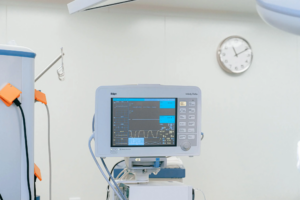Kenya’s healthcare system, like many across Africa, has long grappled with infrastructure limitations, doctor shortages, and uneven access to medical services, especially in rural areas. However, technology is rapidly changing the game.
From AI-powered diagnostics and telemedicine platforms to digital health records and mobile health apps, digital solutions are addressing some of the most pressing systemic challenges in Kenya’s healthcare delivery model. Visionary leaders such as Jayesh Saini, the founder of Lifecare Hospitals, Bliss Healthcare, and Dinlas Pharma, have been pivotal in adopting and scaling technology-driven healthcare solutions across the country.

This article explores the transformative role of health tech in Kenya, showcasing how digital innovation is bridging gaps in access, improving quality of care, and building a more resilient healthcare system.
1. AI in Diagnostics: Faster, Smarter, More Accurate
Artificial Intelligence is redefining how diseases are diagnosed and managed. With limited specialist availability and high patient volumes, AI-driven tools are helping clinicians:
- Analyze medical images like X-rays, CT scans, and MRIs faster.
- Detect early-stage diseases such as cancer or tuberculosis with greater accuracy.
- Support clinical decision-making using large data sets and predictive models.
At Lifecare Hospitals, AI-powered diagnostic systems have been introduced to assist in:
- Early cancer detection, improving treatment outcomes.
- Predictive modeling for chronic disease management, including diabetes and cardiovascular illnesses.
These tools not only increase efficiency in diagnosis but also reduce errors and delays, especially in high-demand settings.
2. Telemedicine: Expanding Access Beyond City Borders
One of the biggest breakthroughs in Kenyan healthcare has been the adoption of telemedicine, which allows patients in remote regions to consult with doctors virtually.
Key Benefits of Telemedicine in Kenya:
- Reduces the need for travel, especially for patients in remote counties.
- Connects rural clinics with urban-based specialists for second opinions.
- Improves follow-up care for chronic conditions.
- Enables mobile outreach through smartphone-based consultations.
Bliss Healthcare, led by Jayesh Saini, has integrated telehealth into its operations by:
- Launching a network of teleconsultation clinics across Kenya, linking patients to qualified physicians and specialists.
- Introducing video-based follow-ups, allowing continued care without repeated hospital visits.
As Kenya continues to expand internet and smartphone access, telemedicine will remain a core pillar of equitable healthcare delivery.
3. Digital Health Records: Streamlining Patient Management
Paper-based records often result in lost medical histories, duplicate tests, and inefficient care coordination. Hospitals are now digitizing records to provide:
- Centralized access to patient histories and treatment plans.
- Improved coordination among departments and across multiple facilities.
- Faster access to critical information, especially during emergencies.
Lifecare Hospitals has fully transitioned to Electronic Health Records (EHR) systems, enabling:
- Cross-hospital access to patient files across its network.
- Enhanced continuity of care through long-term patient monitoring.
- Better clinical audit trails and compliance with care standards.
4. Mobile Health Apps: Empowering Patients to Take Control
In the mobile-first digital age, many hospitals are launching health apps that allow patients to:
- Book appointments without visiting the hospital.
- Access test results and prescriptions through secure digital platforms.
- Receive medication reminders and health tips.
- Track vital signs and manage chronic conditions like hypertension and diabetes.
With the growing popularity of smartphones in Kenya, these platforms are bringing health management directly into the hands of patients.
5. Digital Supply Chains and Pharmaceutical Logistics
Access to quality medicines remains a major challenge due to:
- Inefficient distribution networks.
- Frequent stockouts in rural clinics.
- Heavy reliance on imported medications.
Dinlas Pharma, a pharmaceutical company under Jayesh Saini’s leadership, is transforming this sector by:
- Producing over 140 million tablets and 25 million capsules per month.
- Using digital inventory systems to forecast demand and reduce wastage.
- Distributing medicines across all Kenyan counties, even in underserved regions.
This digital overhaul is improving drug availability, affordability, and traceability, particularly in areas previously affected by inconsistent supply.
6. Challenges in Health Tech Adoption
While the benefits of digital health solutions are clear, Kenya still faces hurdles:
- Digital literacy gaps among healthcare workers and patients.
- Infrastructure challenges, such as unstable electricity and internet in rural areas.
- Data security and patient privacy concerns.
- Initial investment costs for tech-enabled systems.
Addressing these barriers requires ongoing training, robust data governance policies, and collaborative investment between the public and private sectors.
7. The Role of Leadership in Health Tech Integration
The successful integration of digital health relies heavily on visionary leadership. Figures like Jayesh Saini have played a key role by:
- Investing early in AI and telemedicine infrastructure across Lifecare and Bliss Healthcare.
- Promoting digital health as a standard, not a luxury.
- Collaborating with NHIF and the Ministry of Health to align tech-driven care with national health priorities.
Such leadership ensures that technology adoption is purposeful, patient-centered, and scalable.
Conclusion
Health tech is not just a futuristic idea—it is already reshaping the healthcare experience in Kenya. From faster diagnoses and virtual consultations to efficient hospital operations and accessible medication, technology is closing longstanding gaps in the system.
Through the work of forward-thinking healthcare leaders like Jayesh Saini, digital health is becoming more accessible, more affordable, and more effective.
To fully realize this potential, Kenya must continue to:
- Invest in digital infrastructure, especially in rural regions.
- Expand training for health workers on tech adoption.
- Ensure inclusive policies that support public-private collaboration in innovation.
With the right support, Kenya’s healthcare future will be smarter, faster, and more inclusive—powered by the promise of digital solutions.